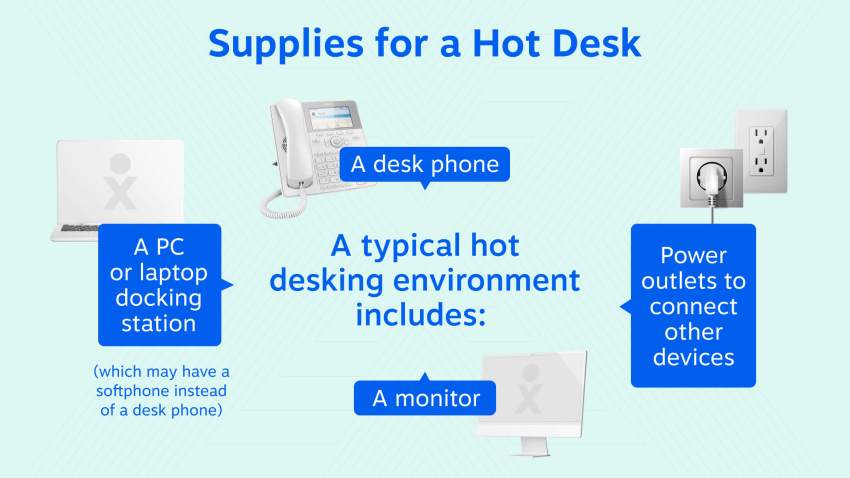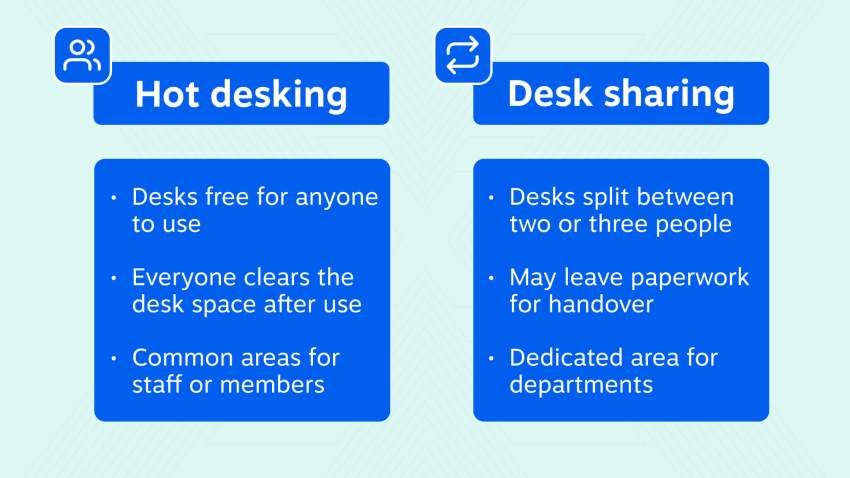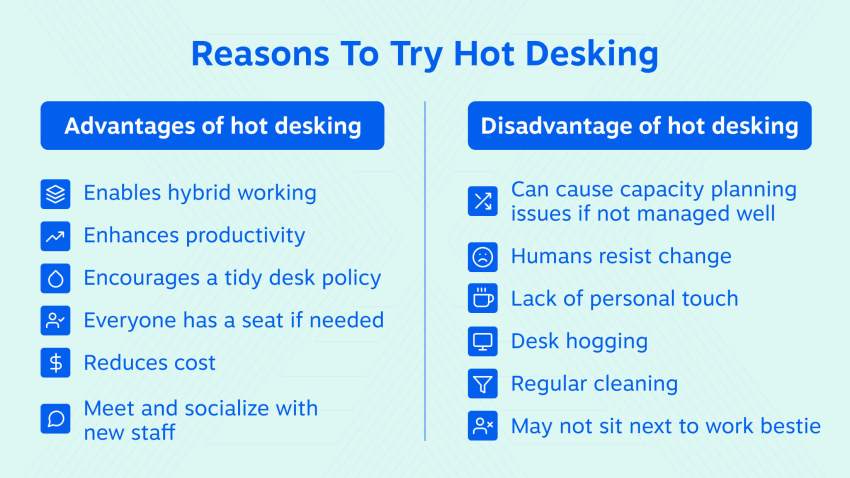Hot desking in your office could go one of two ways. It either drives productivity and saves you tons of communications costs, or everyone hates it and it’s a wasted investment.
The good news is that hot desking is still hot. In fact, on a global scale, 48% of businesses maintain some form of hot desking policy. But you’ve got to get it right — especially when you’re tasked with encouraging employees to use your office more. And hot desking comes with some serious benefits (or repercussions if you get them wrong).
The key to a successful hot desking rollout? Preparation.
Below, we walk you through everything you need to know before you make a decision on implementing a hot desk environment in your business.
Let’s start at the very beginning.
What Is Hot Desking?
Hot desking is an office arrangement where desks are available for use by any staff member. This might be your entire building or sections reserved for specific departments or types of workers.
A typical hot desking setup includes:
- A desk phone (where users can log in using their own phone number)
- A shared PC or laptop docking station
- An ergonomic chair
- An ergonomic keyboard
- A monitor
- Power outlets
- USB charging outlets
- Lockers for storing personal items

The wider office space may also comprise communal meeting areas, private bookable conference rooms, a communal printer, and any other shared office facilities you deem essential.
Employees arrive at the office on any given day and select an available desk to work from, either bookable or on a first-come, first-served basis. They may stay at this desk throughout their workday, move to another area, or leave the building when they’ve fulfilled their reason for being in the office.
While some businesses tend to informally reserve banks of desks for specific departments, it’s not a must-have to make them department-specific. In larger organizations, where it’s common for employees to move between locations, they may be sitting next to a different person every day.
Why is it called hot desking?
No user gets a dedicated desk. The workstation is effectively “hot” and can be used by any member of staff. It’s believed that hot desking gets its name from “hot racking,” which is a term once used by sailors sharing beds due to different shift patterns.
Other names for hot desking include hoteling, desk sharing, shared desks, and flexible workspaces. While these terms are used interchangeably, there are some subtle differences between them.
Hot desking vs. desk sharing vs. hoteling vs. flexible workspaces
| Term | Description |
|---|---|
| Hot Desking | Desks free for anyone to use. Everyone clears the desk space after use. |
| Desk Sharing | Desks split between two or three people, often in the same department and working shifts. May leave paperwork for handover and share licenses for technology. |
| Hoteling | Like staying in a hotel, you need a reservation to use this bank of communal desks. |
| Flexible Workspaces | May comprise hot desks, shared desks, or hoteling. Often a wider remit with shared facilities and communal areas. |
Hot desking example vs. desk sharing
Here’s a basic example of hot desking in action. With hot desking, desk 123 in London is free to anyone:
- Monday: Mohammed arrives at work and logs into desk 123 in the London office.
- Tuesday: Mohammed flies to the San Francisco office and uses desk 456. In London, Julie is now using desk 123.
- Wednesday: Julie uses desk 123 in London again. Mohammed is flying back to London so doesn’t need a desk.
- Thursday: Barry arrives early to work and logs into desk 123 in London. Mohammed and Julie both find alternative desks that are free.
- Friday: 50% of the office work from home. Barry, Mohammed, and Julie are away from the office. The desks are free for anyone to use.

Regardless of who is using the desk, who is a remote worker, or who is an office worker that day, the desk remains a hot desk and is available for any employee to enter your building and use it.
Desk sharing, on the other hand, is ideal for split shifts within the same business, such as a call center that provides 24/7 support. All agents need a desk but not at the same time.
Hot desking is better suited in three main use cases:
- Shared spaces with common areas and workspaces for different businesses. Think of a WeWork or university campus.
- Large businesses with staff who come and go in irregular patterns. These can include sales teams who are often on the road or staff who split their time between home and office.
- Small businesses that don’t need large real estate. If you only have 20 staff but just 10 in the office at any one time, you can cut desk space and realize cost savings.
Is Using Hot Desks a Good Idea?
Hot desking reduces your “dead space” by up to 40%. That’s a stat that’s hard to ignore if you’re tasked with optimizing real estate or cutting IT costs.
Unlike in a traditional office, where you might have assigned desks for your quota of staff head count, using hot desks means you have less space for fewer people. This works just fine if you know or can manage the number of people present in your office at any given time.
But hot desking may not be right for everyone. When thinking about hot desking, ask yourself:
- Will this impact department collaboration in a negative way?
- Do people work from home on a regular basis?
- Is hot desking the right way to encourage people to use the office?
- Will space get used if you create a dedicated hot desking area?
- Do you need space for all your staff to hot desk on the same day?
- How much money will you save by implementing hot desking compared with reserving an unused space for each employee?
- Is hoteling or desk sharing a more suitable option?
Hot desking is right for you if:
- You need to save space and staff are able to work from home some of the time.
- You have staff who frequent different offices.
- You’re looking at cutting costs, and real estate downgrades are an option.
- You’re an agile team that doesn’t require assigned seating.
It might not be the right option for you if:
- Your business needs to reserve desk spaces for certain members of staff.
- Team members plan to share desks based on shift patterns.
- Staff members need specialist equipment (dual monitors, microphones, etc.).
- You work in an industry with strict health regulations.
- Data privacy is a major concern in your industry.
Benefits and Disadvantages of Hot Desking
Using a hot desk setup offers a wide range of benefits that help maximize productivity and real estate savings.
While some employees will view it as a perk, you should also be aware that there are potential downsides to hot desking.
| Benefits of Hot Desking | Disadvantages of Hot Desking |
|---|---|
| Enables hybrid working: Supports flexible work arrangements, allowing employees to split time between home and office. | Can cause capacity planning issues: If not managed well, employees may struggle to find a desk, leading to frustration. |
| Enhances productivity: Employees can choose workspaces that suit their tasks, leading to better focus and efficiency. | May encounter resistance: Some employees may struggle to adapt to a new way of working, causing initial discomfort. |
| Encourages a tidy desk policy: Reduces clutter and ensures workspaces remain clean and organized. | Reduces personal touch: Employees can’t personalize their workspace, which may affect comfort and sense of belonging. |
| Enables flexible seating arrangements: If properly managed, it ensures efficient space utilization and availability for all. | Leads to desk hogging: Without proper rules, employees may unofficially claim desks, defeating the purpose of hot desking. |
| Reduces costs: Minimizes office space requirements, cutting down on rent, utilities, and maintenance expenses. | Requires regular cleaning: Especially in the post-pandemic era, shared workspaces require frequent sanitization to maintain hygiene, increasing operational costs. |
| Enables staff to meet and socialize: Encourages cross-team collaboration and networking, fostering a more inclusive workplace. | Impacts morale: Employees might not get to sit next to or work with their preferred colleagues daily. |
| Supports remote working strategies: Works well for organizations shifting toward remote and hybrid workplaces, ensuring office space is used efficiently. | Depends on technology: Hot desking requires reliable desk booking systems, strong Wi-Fi, and adequate IT support for smooth functioning. |
| Promotes collaboration: Encourages employees to interact with different colleagues, enhancing idea-sharing and teamwork. | Increases risk of noise distractions: Open, unassigned seating can lead to increased background noise, affecting concentration. Some users may thrive in these work environments; others may be restricted and fail to adopt it. |
| Facilitates scaling: Hot desking allows businesses to easily adapt workspace needs based on team size fluctuations. | Doesn’t suit all roles: Some employees, like those handling sensitive data or requiring specialized equipment, may find it unsuitable. |
Who Uses Hot Desking Today?
Maersk, the world’s largest shipping firm with over 80,000 employees, has over 100 locations around the world. At its Maidenhead office in the UK, there are six floors, all with hot desking capabilities. Each team — or block of teams — gets designated a floor so that departments are near each other if needed.
While there is a static array of desks for the in-house IT team, the rest of the floor is open for anyone to take a new seat each day. Meeting rooms and private offices are used around the perimeter of each floor.
At the other end of the scale, StableLogic, a technology consulting firm with around 20 staff, has shared office space in a Regus building.
While most consultants spend time at customer sites, when they return to the Regus building, they have the option to either hot desk from the company’s private office or sit in a common area and log in to a free phone.
Other well-known companies using hot desking include:
- Deloitte
- Microsoft
- Credit Suisse
- Citigroup
- LEGO
- National Australia Bank
We also see hot desks in coworking spaces like WeWork, Regus, and Green Desk.

Tips for Hot Desking Implementations
To make hot desking work, you’ve got to make sure your setup is optimal for your specific business needs. This means ensuring that different workstyles get catered to and understanding how each department operates.
Before you think about technical implementation, it pays dividends to interview key personnel to get a feeling of whether hot desking will be beneficial for all or some staff. From here, you can best plan your number of hot desks and decide who gets access and who needs dedicated or no workspaces in your buildings.
When you roll out hot desking, there are some considerations you must communicate:
- Setting clear usage policies: Include clearing up, booking procedures, noise levels, etc.
- Providing sufficient amenities: Factor in the likely rise in demand for meeting rooms and communal areas when personal workstations are removed.
- Establishing support protocols: Communicate where self-service FAQs can be found — as well as how to log tickets and get real-time support.
From a technical perspective, think about:
- Integrating with other business apps: Account for CRM software, email solutions, and other collaboration tools.
- Monitoring usage: Uncover insights about when and where hot desking gathers momentum and think about different strategies for areas with low uptake.
- Finding the right phone system provider: Choose a partner with 24/7 support, known for great customer service and technical support.
Set Up Your Hot Desks With Nextiva
To give yourself the best chance of a successful hot desking rollout, you need the best underlying infrastructure.
In the case of hot desking, you need a phone system that supports both your hot desk users and any other type of user you choose to configure. And you need it to be low latency, HD quality, and easy to get started.

Nextiva’s award-winning VoIP solution includes hot desking, free to set up, alongside a wealth of other features:
- Call Routing: Automatically direct incoming calls based on criteria like phone number, agent capabilities, or the time of day.
- Call Analytics: Measure real-time phone call volume for VoIP calls, auto attendants, or locations.
- Call Recording: Silently record any phone call made through your telephone system without any adapters.
- Voicemail Transcription: When you can’t answer an incoming call, get an email or text message with an accurate voicemail transcript.
- Business Text Messaging: Exchange SMS text messages with customers and team members from your desktop or mobile app — perfect for a quick check-in.
- Video Conferencing: Host video meetings with your team, including chat and business conference calls for clients.
- Admin Management: Add employees to your VoIP phone system and streamline your handset setup with pre-configured VoIP desk phones.
Is hot desking right for you? Check out Nextiva’s VoIP phone system here. 👇
The best VoIP phone system for businesses.
Get a complete business phone system with advanced features and superior call quality for less.

















 Productivity
Productivity 








